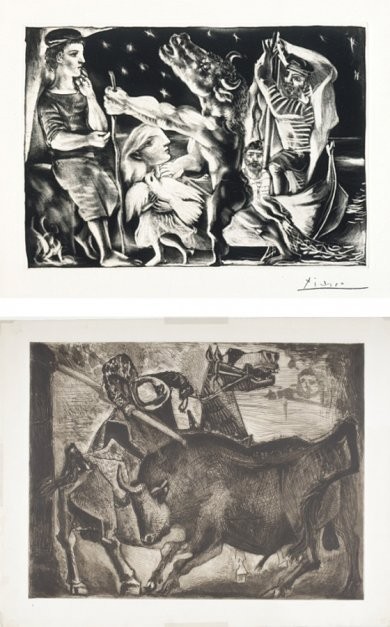Picasso and his Printers
23 Jul - 27 Nov 2016

above: Pablo Picasso, Blind Minotaur Led through the Night by Girl with Fluttering Dove, 1934, Los Angeles County Museum of Art, Graphic Arts Council Fund;
below: Pablo Picasso, Taureau et Picador, 1952, Los Angeles County Museum of Art, gift of the 2014 Collectors Committee; both © 2015 Estate of Pablo Picasso/Artists Rights Society (ARS), New York
below: Pablo Picasso, Taureau et Picador, 1952, Los Angeles County Museum of Art, gift of the 2014 Collectors Committee; both © 2015 Estate of Pablo Picasso/Artists Rights Society (ARS), New York
PICASSO AND HIS PRINTERS
23 July 2016 – 27 November 2016
Picasso’s prodigious output of prints, spanning all seven decades of his career, is characterized by constant experimentation and technical ingenuity. Different printmaking techniques fueled his creative energy, as each method presented distinct means and possibilities for expression.
The stimulus and support Picasso received from his master printers were critical to his exploration of graphic art. His first decades of drypoints and etchings tend toward more conventional applications of technique—but in the mid-1930s, the artist adopted a radically new and bold approach when he began his close association with the printer Roger Lacourière. Similarly, in his later collaborations with the printers Fernand Mourlot in lithography and Hidalgo Arnéra in linocut, Picasso pressed the boundaries of what could be realized in each medium.
Through his cooperative work with printers, Picasso sustained his lifelong commitment to innovating techniques, often through unorthodox methods. Largely drawn from LACMA’s collection, Picasso and His Printers celebrates the great achievements of these vital collaborations.
This installation was organized by the Los Angeles County Museum of Art.
23 July 2016 – 27 November 2016
Picasso’s prodigious output of prints, spanning all seven decades of his career, is characterized by constant experimentation and technical ingenuity. Different printmaking techniques fueled his creative energy, as each method presented distinct means and possibilities for expression.
The stimulus and support Picasso received from his master printers were critical to his exploration of graphic art. His first decades of drypoints and etchings tend toward more conventional applications of technique—but in the mid-1930s, the artist adopted a radically new and bold approach when he began his close association with the printer Roger Lacourière. Similarly, in his later collaborations with the printers Fernand Mourlot in lithography and Hidalgo Arnéra in linocut, Picasso pressed the boundaries of what could be realized in each medium.
Through his cooperative work with printers, Picasso sustained his lifelong commitment to innovating techniques, often through unorthodox methods. Largely drawn from LACMA’s collection, Picasso and His Printers celebrates the great achievements of these vital collaborations.
This installation was organized by the Los Angeles County Museum of Art.
